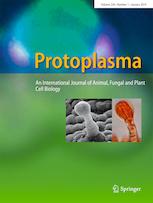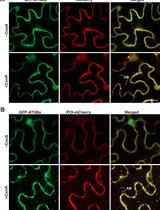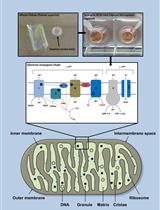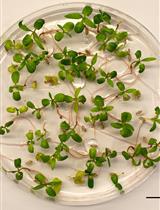- EN - English
- CN - 中文
Visualization of Nitric Oxide, Measurement of Nitrosothiols Content, Activity of NOS and NR in Wheat Seedlings
小麦幼苗中一氧化氮可视化以及亚硝基硫醇含量和NOS、NR活性测定
发布: 2019年10月20日第9卷第20期 DOI: 10.21769/BioProtoc.3402 浏览次数: 6271
评审: Khyati Hitesh Shahsivareddy kotlaXiaofei Liang
Abstract
Nitric oxide (NO), is a redox-active, endogenous signalling molecule involved in the regulation of numerous processes. It plays a crucial role in adaptation and tolerance to various abiotic and biotic stresses. In higher plants, NO is produced either by enzymatic or non-enzymatic reduction of nitrite and an oxidative pathway requiring a putative nitric oxide synthase (NOS)-like enzyme. There are several methods to measure NO production: mass spectrometry, tissue localization by DAF-FM dye. Electron paramagnetic resonance (EPR) also known as electron spin resonance (ESR) and spectrophotometric assays. The activity of NOS can be measured by L-citrulline based assay and spectroscopic method (NADPH utilization method). A major route for the transfer of NO bioactivity is S-nitrosylation, the addition of a NO moiety to a protein cysteine thiol forming an S-nitrosothiol (SNO). This experimental method describes visualization of NO using DAF-FM dye by fluorescence microscopy (Zeiss AXIOSKOP 2). The whole procedure is simplified, so it is easy to perform but has a high sensitivity for NO detection. In addition, spectrophotometry based protocols for assay of NOS, Nitrate Reductase (NR) and the content of S-nitrosothiols are also described. These spectrophotometric protocols are easy to perform, less expensive and sufficiently sensitive assays which provide adequate information on NO based regulation of physiological processes depending on the treatments of interest.
Keywords: Nitric oxide (NO) (一氧化氮)Background
Nitric oxide (NO) is emerging as a key regulator of diverse plant cellular processes like regulating synthesis of the cell wall (Correa-Aragunde et al., 2008; Xiong et al., 2009; Ye et al., 2015), ROS metabolism in plants (Delledonne et al., 2001), gene expression and regulation (Bogdan et al., 2000), programmed cell death (de Pinto et al., 2002), maturation and senescence (Yaacov et al., 1998). NO exerts a crucial role in protecting plants against various abiotic stresses (Hung et al., 2002). NO could significantly enhance antioxidative capacity by increasing the activities of catalase (CAT), ascorbate peroxidase (APX) and accumulating proline during wheat seed germination under osmotic stress (Zhang et al., 2003). A major route for the transfer of NO bioactivity is S-nitrosylation, the addition of a NO moiety to a protein cysteine thiol forming an S-nitrosothiol (SNO). Total cellular levels of protein S-nitrosylation are controlled predominantly by S-nitrosoglutathione reductase 1 (GSNOR1) which turns over the natural NO donor, S-nitrosoglutathione (GSNO). In the absence of GSNOR1 function, GSNO accumulates, leading to dysregulation of total cellular S-nitrosylation (Yun et al., 2016)
Nitric oxide (NO) production in land plants classically involves two main routes: first, a reductive pathway involving both enzymatic and non-enzymatic reduction of nitrite into NO (Gupta et al., 2011); second, an oxidative pathway requiring a putative nitric oxide synthase (NOS)-like enzyme. Role of NR in NO production was suspected by low or no NR activity mutants which show no measurable NO. Later nia1/nia2 double mutants of Arabidopsis confirmed the role of NR in reduction of NO2- to NO in NADH dependent manner under both in vitro (Yamasaki et al., 1999) and in vivo (Vanin et al., 2004) condition. The possibility that NOS could catalyze NO synthesis in plants has also been a main controversial issue. Experimental evidence further increased suspicion about the existence of a plant NOS-like enzyme. It was reported that the L-citrulline based assay commonly used to measure a NOS activity in plant extracts is prone to artefacts (Tischner et al., 2007).
Several methods have been reported for nitric oxide assay in plants which includes gas chromatography and mass spectrometry (Neil et al., 2003; Conarth et al., 2004, Bethke et al., 2004), laser photo-acoustic spectroscopy (Lesham and Pinchasov, 2000), NO electrode (Yamasaki et al., 2001), electron paramagnetic resonance (EPR) (Sun et al., 2018) and a group of florescent dye indicators which are available in acetylated form for intracellular measurements like Diaminofluorescein-FM (DAF-FM) (Du et al., 2016). Fluorescent dye indicator and EPR both are highly specific for NO. EPR is limited by inability to detect low level NO production and insolubility of chelating agent. Use of fluorogenic probe DAF-FM is gaining more importance because of their simplicity, high sensitivity towards NO and are essentially independent of pH above pH 5.5. This probe is membrane-permeant and deacylated by intracellular esterases to 4-amino-5-methylamino-2 V, 7 V-difluorofluorescein. Presence of light leads to autoxidation of Diaminofluorescein-FM (DAF-FM) dye and simultaneous presence of NO and superoxide source (like xanthine + xanthine oxidase) decreases the fluorescence of Diaminofluorescein-FM (DAF-FM), resulting in underestimation of nitric oxide production (Balcerczyk et al., 2005). This limits the use of Diaminofluorescein-FM (DAF-FM) in stress-related study.
The activity of NOS can be measured by L-citrulline based assay (Tischner et al., 2007) and spectroscopic method (NADPH utilization method) (Gonzalez et al., 2012). Citrulline-based assay measures the formation of L-citrulline from L-arginine using ion exchange chromatography. The assay does not exactly quantify citrulline; any arginine derivative that does not bind to the cation exchange resin will give a signal and leads to false measurement and also involve radiolabelling which may be tedious to handle (Tischner et al., 2007). Spectrophotometric measurement of NOS activity has been widely regarded as a less expensive and sufficiently sensitive assay for routine laboratorial experiments.
Nitrate reductase activity can be measured by an in vitro or an easy to perform in vivo method (Nair and Abrol, 1973). We have used these protocols to study the effect of elevated CO2 (EC) and nitrate supply on nitrogen metabolism in wheat seedlings (Adavi and Sathee, 2019). S-nitrosylation of NR by EC induced NO produced in plants supplied with high nitrate concentration decreases the enzyme activity (Cheng et al., 2015; Du et al., 2016).
Materials and Reagents
- 50 ml glass culture tubes without rim (Borosil, catalog number: 9820U08)
- Scalpel Blade No.10 (Himedia, catalog number: LA76808)
- Paint Brush (Faber-Castell, size-2)
- Glass slide (Himedia, catalog number: LA76808) and cover slip (Himedia, catalog number: GW064)
- Needle (Himedia)
- Kimwipes®
- Moist filter paper
- Butter paper bags
- Wheat seed
- Double distilled water
- 2-(4-carboxy phenyl)-4,4,5,5-tetramethyl imidazoline-1-oxyl-3-oxide (cPTIO, Sigma-Aldrich, 200 µM, catalog number: C221)
- Diaminofluorescein-FM (DAF-FM, Sigma-Aldrich, catalog number: D1821)
- HEPES (Sigma-Aldrich, catalog number: RDD002)
- Potassium nitrate (KNO3) (Fischer Scientific, catalog number:13655)
- N-nitro arginine methyl ester (L-NAME, Sigma-Aldrich, catalog number: N5751)
- Phosphate buffer 200 mM pH 7.5
- Sodium nitroprusside (SNP, Sigma-Aldrich, catalog number: BP453)
- Sodium tungstate (Na-Tungstate, Sigma-Aldrich, catalog number: 14304)
- NEDD (Sisco Research Laboratories Pvt. Ltd, catalog number: 61166)
- N-propanol
- Ammonium Sulfonate (Sisco Research Laboratories Pvt. Ltd, catalog number: 62419)
- HgCl2 (Sisco Research Laboratories Pvt. Ltd, catalog number: 25699)
- Sulfanilamide (Sisco Research Laboratories Pvt. Ltd, catalog number:19689)
- Ferric-EDTA (Sisco Research Laboratories Pvt. Ltd, catalog no 59389)
- Assay buffer (Phosphate buffer, 100 mM, pH 7.0)
- L-Arginine (Sisco Research Laboratories Pvt. Ltd, catalog number: 66637)
- MgCl2 (Sisco Research Laboratories Pvt. Ltd, catalog number: 69396)
- CaCl2 (Sisco Research Laboratories Pvt. Ltd, catalog number: 70650)
- BH4 ((6R)-5,6,7,8-Tetrahydrobiopterin dihydrochloride, Sigma-Aldrich, 100 µM, catalog number: 14304)
- FAD (Sisco Research Laboratories Pvt. Ltd, catalog number: 87939)
- FMN (Sisco Research Laboratories Pvt. Ltd, catalog number: 57443)
- DTT (Sisco Research Laboratories Pvt. Ltd, catalog number: 84834)
- PMSF (Sisco Research Laboratories Pvt. Ltd, catalog number: 87606)
- NADPH (Sisco Research Laboratories Pvt. Ltd, catalog number: 77268)
- Bradford reagent (Genetix Biotech Asia Pvt. Ltd, catalog number: E530-1L)
- 0.25% HgCl2 in 0.1 N HCl
- 7% sulfanilamide in 1 N HCI
- 100 µM Sodium nitroprusside (prepared in double distilled water)
- 100 µM Sodium tungstate) (prepared in double distilled water)
- 0.1% NEDD (prepared in double distilled water)
- 0.5% Ammonium sulfonate (prepared in double distilled water)
- 0.2 mM NADPH (prepared in double distilled water)
- Nitrogen free Hoagland solution (see Recipes)
- NOS extraction buffer (see Recipes)
- S-nitrosothiol extraction buffer (see Recipes)
- HEPES-KOH with pH 7.5 (see Recipes)
Equipment
- Growth chamber (Conviron, Winnipeg, Canada, model: PGW 36,)
- Watch glass (Himedia, catalog number: LA025)
- Mortar and pestle
- Fluorescence microscope (Zeiss AXIOSKOP 2)
- UV-visible spectrophotometer (Analytik Jena, Germany, model: Specord Bio-200)
- Refrigerated centrifuge (Sigma 3K30)
- Aerator Pump
- Water bath
Software
- ImageJ (https://imagej.nih.gov/ij/download.html)
- MS Excel
- SPSS 10.0
Procedure
文章信息
版权信息
© 2019 The Authors; exclusive licensee Bio-protocol LLC.
如何引用
Adavi, S. B., Sathee, L., Padhan, B. K., Singh, O., Meena, H. S., Durgesh, K. and Jha, S. K. (2019). Visualization of Nitric Oxide, Measurement of Nitrosothiols Content, Activity of NOS and NR in Wheat Seedlings. Bio-protocol 9(20): e3402. DOI: 10.21769/BioProtoc.3402.
分类
植物科学 > 植物生理学 > 营养
植物科学 > 植物生理学 > 新陈代谢
细胞生物学 > 细胞成像 > 荧光
您对这篇实验方法有问题吗?
在此处发布您的问题,我们将邀请本文作者来回答。同时,我们会将您的问题发布到Bio-protocol Exchange,以便寻求社区成员的帮助。
Share
Bluesky
X
Copy link














